Seafood is hip again in Tokyo
Tokyoites are flocking to the flavors of Italian, Portuguese, Sicilian and Japanese seafood like never before. Discover what the fuss is about by visiting one of these fine restaurants recommended by Savor Japan this spring.
 Mar de Cristiano
Portugal meets Japan
Mar de Cristiano
Portugal meets Japan
 Akoya
Simply marvelous mollusks
Akoya
Simply marvelous mollusks
 Bogamari Cucina Marinara
Italian port charm
Bogamari Cucina Marinara
Italian port charm
 Osteria da Káppa
Italian recipes. Japanese seafood.
Osteria da Káppa
Italian recipes. Japanese seafood.
 Rozzo Sicilia
Authentic Sicilian in Japan
Rozzo Sicilia
Authentic Sicilian in Japan
Mar de Cristianoマル・デ・クリスチアノ
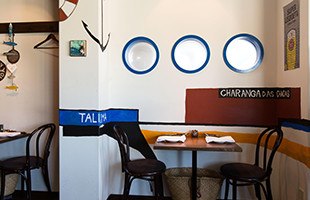
Phone: 03-6804-7923
- Address:
- 4F, Suncity Tomigaya, 1-3-12 Tomigaya, Shibuya-ku, Tokyo
- Open:
- [Tuesday - Saturday, Day before Holidays] 6:00 pm - L.O.
12:00 am [Sunday, Holidays] 6:00 pm - L.O. 11:00 pm - Closed:
- Monday
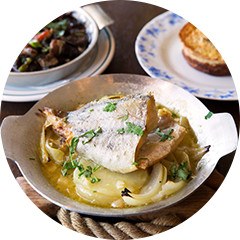 Where to begin
Where to begin
Where to begin
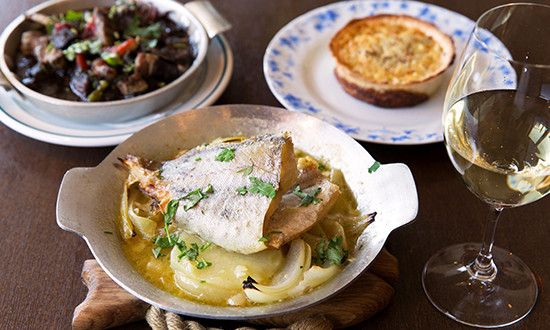
Owner chef Sato confesses, "I'm not serious about trying to serve authentic Portuguese cuisine". Instead, he focuses on preparing Japanese seafood in a Portuguese way. This helps explain why there are so many items on the menu.
Every dish, from European-style simmered mackerel tarts to salt pork back ribs with squid ink and simple charcoaled fish, is served with charm.

Baked homemade Bacalhau. The cod in this signature Portuguese dish is hand salted and dried to create a multifaceted flavor that overflows as you chew.
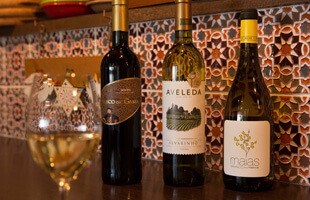
Many Portuguese wines are produced through traditional techniques and have a strong, earthy body.

Sato's jolly countenance conceals a perfectionism driven by deep knowledge of seafood and a demand for exquisite taste.
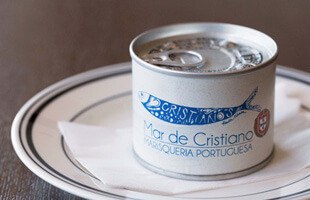
Homemade canned fish is a specialty. Sato cans fish to enhance its flavor rather than for preservation purposes.

The interior is reminiscent of the sea. Windows provide a splendid view of glittering Nishi-Shinjuku skyscrapers.
Portugal meets Japan
Portuguese cuisine was largely unknown in Japan until the launch of Cristiano restaurant in Yoyogi-Hachiman. Thereafter, it has been gaining widespread acclaim. The restaurant's owner, Koji Sato, later opened Mar de Cristiano as an exclusive seafood branch to reinvigorate seafood culture in Japan.
Half of Portugal borders the sea and its cuisine includes a wide range of seafood dishes, many of which resemble popular dishes in Japan. These include shioyaki (salt-grilled) fish and himono (dried fish), for example. Now many Japanese are rediscovering the value of Japanese seafood by dining on Portuguese cuisine in Japan.
Owner Sato keeps the prices reasonable to encourage regular patronage. He built a strong network with seafood co-ops all over Japan by initially visiting them firsthand and then keeping in touch every day to check on fishing conditions. Based on the solid trust he earned through these contacts, he acquires seafood unavailable through the fish market that arrives fresh at his restaurant every day.
The menu includes a rich array of Portuguese dishes, but Sato remarks, "I'm pleased that many guests think shioyaki (salt-grilled) fish is our best tasting dish". With a deep love for seafood, he is challenging Japan's culinary trend away from seafood towards meat.

Phone: 03-6804-7923
- Address:
- 4F, Suncity Tomigaya, 1-3-12 Tomigaya, Shibuya-ku, Tokyo
- Open:
- [Tuesday - Saturday, Day before Holidays] 6:00 pm - L.O.
12:00 am [Sunday, Holidays] 6:00 pm - L.O. 11:00 pm - Closed:
- Monday
Akoyaあこや

Phone: 03-6451-2467
- Address:
- 1F, TIMEZONE Ogawa Bldg., 1-4-4 Ebisuminami, Shibuya-ku, Tokyo
- Open:
- 6:00 pm – L.O. 11:00 pm
- Closed:
- Irregular
 Where to begin
Where to begin
Where to begin
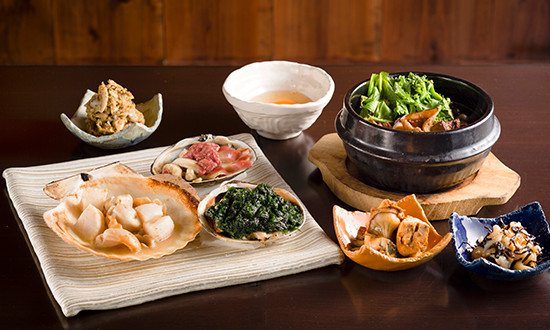
Comparing the flavors of different types of shellfish is one of the great joys of dining at Akoya. We especially recommend the chef's choice appetizer, a well-balanced assortment of asari (short neck clams) namerou (minced and mixed with kimo miso paste), aoyagi (round clams) with shiokonbu (strips of salted kelp), and two blends of tairagai (pen shell) and mirugai (geoduck clams) intestines simmered in soy sauce and sugar.

Ito's simple recipes require masterful technique to achieve the right texture and flavor. Trained as a Washoku (Japanese cuisine) chef, he prepares exquisite dashi for chawan-mushi (steamed custard), tamagoyaki (omelet) and other dishes.

Clam kimo (intestines) sukiyaki is simmered and dipped in raw egg. Rice can be added to the leftovers to make ojiya (porridge).
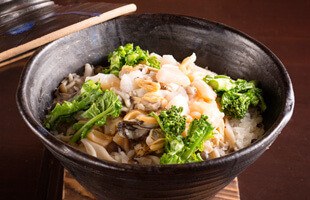
Kamameshi (iron pot cooked rice) with Uonuma Koshihikari Yukizatomai rice, flavorful clams and other ingredients selected by the customer.
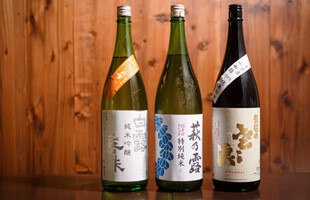
Approximately 30 brands of jizake (local sake) are kept in stock. Ito personally visits breweries to select brands that best match his shellfish.
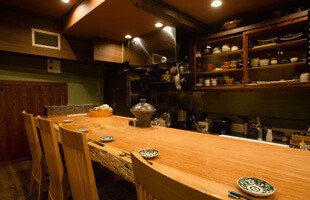
The shop is decorated with sake barrel boards from breweries, antique shelves, antique tableware and handmade pottery.
Simply marvelous mollusks
The distinctive aroma of grilled seafood fills the restaurant, which resembles a sake brewery that matured over the years. Behind a huge wooden counter made from a single block of wood, sazae (turbans) and awabi (abalones) sizzle on a grill to proclaim they are ready for serving. Live kaki (oysters) are also being shucked, one after the other, on a cutting board beside the grill. The menu boasts a diverse range of grilled and steamed dishes, rice dishes, steaks and appetizers. But the shellfish menu, ranging from amuse bouche to clam cuisine, is especially impressive. Akoya restaurant clearly specializes in shellfish.
Owner chef Yusuke Ito, who prepares and serves meals with remarkable skill, was originally a Washoku (Japanese cuisine) chef. Obsessed with the marvelous cuisine served at sister restaurant Abusan, he frequented the shop for nearly 6 years before becoming an apprentice of its owner, Yongyu Nobuta, a legendary seafood chef. After three years of training and establishing a steady patronage, Ito launched his own restaurant, Akoya. "Above everything else," he tells us, "I'm confident about the freshness of my ingredients. My goal is to merely extract the essence of the ingredients in a simple, careful way. It's a difficult task, but pleasurable as well."
His grilled dishes are served with a rich variety of seasonings, such as butter soy sauce on hotate (scallops), katsuo shuto (salted bonito innards) on hokki (surf clam), and raw seaweed on large asari (short neck clams). By comparing different dishes, customers come to understand that each is skillfully planned to draw out the strengths of the particular shellfish. Likewise, numerous brands of jizake (local sake) are available to perfectly complement every dish. The rich choices for finishing off the meal include onigiri (rice balls) filled with specially blended mirugai (geoduck clams) and tairagai (pen shell), and risotto made from asari (short neck clam) and hamaguri clam broth. Guests treasure every delicious bite as if finding shining pearls in the shells.

Phone: 03-6451-2467
- Address:
- 1F, TIMEZONE Ogawa Bldg., 1-4-4 Ebisuminami, Shibuya-ku, Tokyo
- Open:
- 6:00 pm – L.O. 11:00 pm
- Closed:
- Irregular
Bogamari Cucina Marinaraボガマリ・クチーナ・マリナーラ
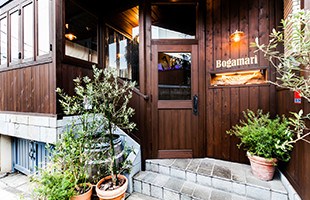
Phone: 03-6721-1858
- Address:
- 1F, Garden View Kitasando, 4–7-5, Sendagaya, Shibuya-ku, Tokyo
- Open:
- [Weekdays, Saturdays, Holidays, Day before Holidays] Lunch 11:30 am – L.O. 2:00 pm / Dinner 6:00 pm – L.O. 10:00 pm
- Closed:
- Sunday
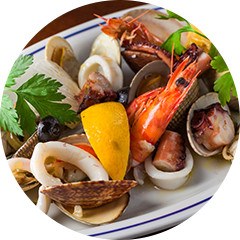 Where to begin
Where to begin
Where to begin

If the amazing diversity of seafood at Bogamari Cucina Marinara makes it difficult to choose what to eat, we recommend "marinated seafood in orange flavor", which provides a sampling of several varieties. The fruity nuance and refreshing acidity will stimulate your appetite and raise your expectations toward the next delectable dish.
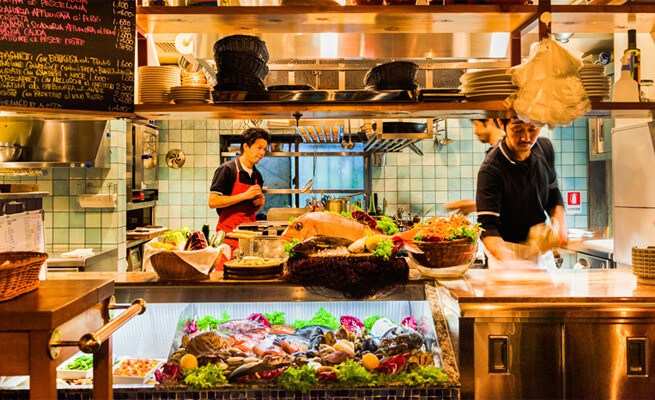
The open kitchen, a Japanese interpretation of a charming Italian fishing port, is with superb ingredients and culinary expertise. Over 30 types of dry and homemade pasta are served and on display.

Bogamari-style uni (sea urchin) spaghetti, chef Hirayama's specialty, features sea urchins from wherever they are seasonally best in Japan.

Hobo (sea robin) with white wine and artichoke sauce. Anchovies and lemon slices tastily accent the white flesh.

Approximately 300 types of wine from all over Italy are available for your drinking pleasure. Around 70% are whites.
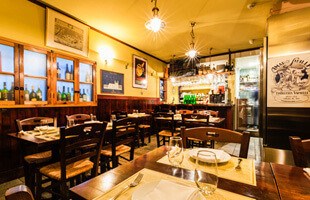
The elegant room, reminiscent of a ship's cabin, and ocean fragrance from the kitchen make it easy to forget you're in the center of Tokyo.
Italian port charm
Bogamari Cucina Marinara's kitchen counter colorfully showcases the day's catch. Fresh humanely killed hokke (Atka mackerel), sudaregai (Venus clams), and still moving zoriebi (Japanese mitten lobsters) are among the rare species on display. It's a menu that brings gasps of admiration upon first glance. By the time evening arrives, seafood caught that morning at nearly a dozen ports from Hokkaido to Kyushu decorate the counter. This constant selection of fresh and tasty rarities is made possible by an original network established firsthand by the staff through visits to ports all over Japan. The passion of staff members describing what cooking method best matches each type of seafood is contagious. It's like a fish market, except that Bogamari Cucina Marinara offers seafood rarely found at fish markets.
After selecting your desired seafood, the next step is deciding how to prepare it. Those acquainted with Italian cuisine often express their personal preferences, while others receive expert suggestions from the staff. "It really excites me when I receive detailed requests from European customers," chef Takayuki Hirayama tells us. His knowledge of local recipes throughout Italy is profound, especially from cities along the coast. But he doesn't simply reproduce the flavors of Italy. His soup base, for example, never contains meat or meat byproducts because he wants seafood to be the focus of the flavor.
Italian-made tuna bottarga brings out the body of the Bogamari-style uni (sea urchin) spaghetti. In early spring, its sauce also includes bafun-uni (green sea urchin) for a fabulous, multi-layered taste. Imagine how much effort it took for such fresh, rare seafood to reach your plate!

Phone: 03-6721-1858
- Address:
- 1F, Garden View Kitasando, 4–7-5, Sendagaya, Shibuya-ku, Tokyo
- Open:
- [Weekdays, Saturdays, Holidays, Day before Holidays] Lunch 11:30 am – L.O. 2:00 pm / Dinner 6:00 pm – L.O. 10:00 pm
- Closed:
- Sunday
Osteria da KáppaOsteria da K.[Kappa]
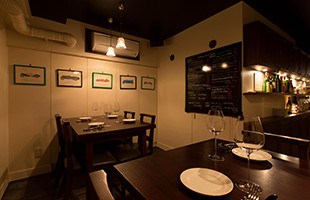
Phone: 03-6274-6620
- Address:
- 5F, Ginza Fujii Bldg. No.2, 8-7-2, Chuo-ku, Tokyo
- Open:
- [Weekdays, Day before Holidays] 6:00 pm - L.O. 11:00 pm
[Saturday] 5:00 pm - L.O. 9:00 pm - Closed:
- Sunday, Holidays
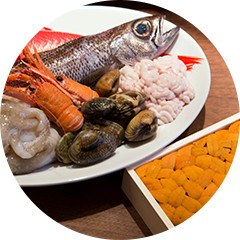 Where to begin
Where to begin
Where to begin

Fine ingredients, expert preparation and subtle ingenuity are the hallmarks of every dish at Osteria da Kappa. The acqua pazza fish is lightly grilled to add flavor, then poached in stock made from fish bones and parts. The cold uni (sea urchin) pasta is mixed with raw nori (seaweed) to intensify the seafood flavor. And the carpaccio, a chef special we highly recommend, is prepared with Edomae (old Tokyo) techniques such as letting the fish sit in salt, sandwiching it between sheets of kelp and grilling the skin.

Hobo (sea robin) acqua pazza. The fish variety varies daily and may include kinme (alfonsino) or nodoguro (blackthroat sea perch), which sell out fast.
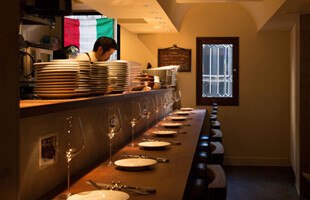
Counter seats at the open kitchen provide a clear view of chef Isogai working his magic.
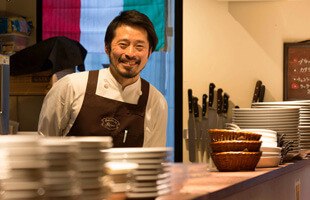
"As a chef, I'm very happy to be using first-class ingredients," says Isogai, who devotes much of his time to researching recipes.

The menu of 70 to 80 Italian wines includes reds, from which the sommelier can make selections that complement your dish.
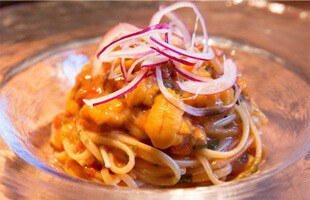
Cold babettini with uni (sea urchin) and raw nori (seaweed) is the chef's specialty. Thick with rich sea urchin, the flavor is incredible.
Italian recipes. Japanese seafood.
Have you heard of Sushi Yoshitake? Since moving to Ginza in 2010 from Roppongi, where it was established in 2005, it has earned 3 stars and become one of Japan's most famous sushi restaurants. Sushi Yoshitake runs Osteria da Kappa Italian restaurant.
Why would a leading sushi restaurant run an Italian restaurant? Because both serve seafood of the finest quality. Osteria da Kappa's diverse menu includes rich uni (sea urchin) pasta, premium nodoguro (blackthroat sea perch) or splendid kinme (alfonsino) in acqua pazza, and even honmaguro (big Bluefin) from Oma in puttanesca. Unsurprisingly, this Italian restaurant has become renowned for its exceptionally delicious seafood.
The kitchen is run by chef Katsunari Isogai, who not only mastered the art of Italian cuisine, but also trained for a year at Sushi Yoshitake. His rare combination of Italian technique and Edomae (old Tokyo) sushi skills combines with an unerring eye for quality fish to bring uncommon depth and breadth to the cuisine. Add unrivaled access to Japan's finest seafood and you have a winning combination of taste and quality that leaves gourmets shouting in admiration.

Phone: 03-6274-6620
- Address:
- 5F, Ginza Fujii Bldg. No.2, 8-7-2, Chuo-ku, Tokyo
- Open:
- [Weekdays, Day before Holidays] 6:00 pm - L.O. 11:00 pm
[Saturday] 5:00 pm - L.O. 9:00 pm - Closed:
- Sunday, Holidays
Rozzo Siciliaロッツォ シチリア
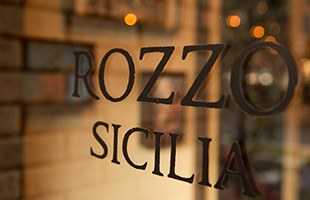
Phone: 03-5447-1955
- Address:
- 1F, Uchino mansion, 1-1-12, Shirokane, Minato-ku, Tokyo
- Open:
- [Weekdays, Saturdays, Holidays, Day before Holidays] 6:00
pm - L.O. 11:00 pm - Closed:
- Sunday
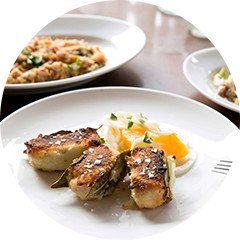 Where to begin
Where to begin
Where to begin

Savor couscous passed down from the Arab occupation, fish marinated in olive oil, and the most traditional Sicilian dish of all, marlin involtini. Customers born and raised in Sicily will find this menu familiar. Guests visiting Rozzo Sicilia experience not only mouthwatering fare, but also the exotic atmosphere of a faraway land.
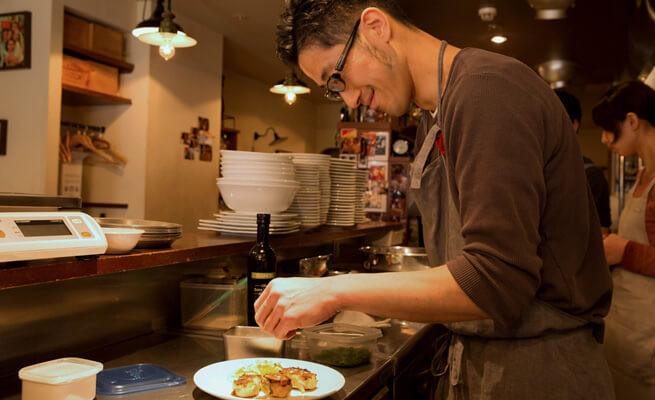
While preserving the original flavors of Sicilian cuisine, chef Nakamura's original interpretation adds the appeal of Japanese seafood. Every dish has a strong impact and lingering taste.
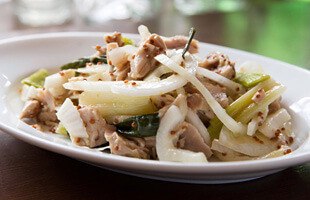
Classic Sicilian salad featuring tuna marinated in olive oil with young onions and whole grain mustard.
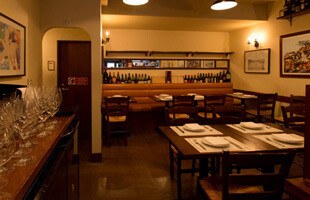
Order a la carte dishes to your heart's content in a casual ristorante atmosphere as authentic as they come.

Sicilian seafood couscous made extra delicious with the rich taste of shrimp, squid and white fish meat.

The heavenly homemade liqueur is made from fruit soaked in rum or gin as a digestif. But be careful not to drink too much, as it's strong!
Authentic Sicilian in Japan
Ruled by the Greek, Roman, Arab and other empires throughout the ages, Sicily developed its own unique food culture characterized by simple island fare with plenty of seafood and vegetables. At Rozzo Sicilia, you can feast on authentic rozzo (unaffected, candid) Sicilian cuisine.
Chef Yoshimichi Nakamura became entranced with Italian food at the age of 22, then rigorously studied Sicilian cooking in Japan and moved to Sicily. His first impression there was, "the local dishes are quite similar to Sicilian cuisine in Japan". Of course, certain details can only be experienced in Sicily, but the same flavors can be recreated quite faithfully in Tokyo, where all the ingredients and seasonings are readily available.
After three years of studying in Sicily, he returned to Japan and opened Rozzo Sicilia with an old friend from his training days, Tsutomu Abe. "This restaurant wouldn't be out of place in Sicily," the chef assures us, and indeed, the capers, olives and anchovies are all imported from Italy. But the fresh vegetables, fruits and seafood from Japan are in no way inferior to those in Sicily. With wizardry, chef Nakamura transforms Japanese ingredients into delicious, authentic Sicilian cuisine, a fascinating feat.

Phone: 03-5447-1955
- Address:
- 1F, Uchino mansion, 1-1-12, Shirokane, Minato-ku, Tokyo
- Open:
- [Weekdays, Saturdays, Holidays, Day before Holidays] 6:00
pm - L.O. 11:00 pm - Closed:
- Sunday
*Articles are written based on information available at the time of publication.
More restaurants


